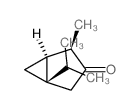Skeletal muscle fatty acid oxidation is not directly associated with AMPK or ACC2 phosphorylation.
Hakam Alkhateeb, Graham P Holloway, Arend Bonen
Index: Appl. Physiol. Nutr. Metab. 36(3) , 361-7, (2011)
Full Text: HTML
Abstract
Rescue of palmitate-induced insulin resistance has been linked with improvements in fatty acid oxidation, but importantly, not always with concurrently altered AMPK or ACC2 phosphorylation. Therefore, we examined the interrelationships among AMPK, ACC2, and fatty acid oxidation under 12 controlled conditions in isolated muscle. Incubation of soleus muscle (0-12 h) did not alter fatty acid oxidation, but did increase AMPK and ACC2 phosphorylation (24%-30%). Muscle incubation with palmitate (2 mmol·L(-1)) inhibited palmitate oxidation (∼55%), but paradoxically, this was associated with increased AMPK and ACC2 phosphorylation (∼50%). Addition of an AMPK activator (thujone) to control (no palmitate) muscle increased AMPK and ACC2 phosphorylation (∼25%) but did not alter palmitate oxidation. Addition of AMPK inhibitors, compound C (50 µmol·L(-1)) or adenine 9-β-d-arabinofuranoside (Ara; 2.5 mmol·L(-1)), to thujone-treated muscles (no palmitate) did not alter palmiate oxidation but reduced AMPK phosphorylation (32%-42%), while ACC2 phosphorylation remained above basal level (+14%-18%). Finally, in palmitate-treated muscle, thujone increased AMPK (+100%) and ACC2 phosphorylation (+52%) and restored palmitate oxidation. Compound C or Ara, administered along with thujone in palmitate-treated muscle, only partly blunted palmitate oxidation recovery despite inhibiting AMPK phosphorylation (-22%), although ACC2 phosphorylation remained upregulated (+33%). Among these experiments, AMPK phosphorylation and ACC2 phosphorylation were positively correlated. However, AMPK phosphorylation was not correlated with palmitate oxidation, and unexpectedly, palmitate oxidation was negatively correlated with ACC2 phosphorylation. Our study, in accordance with a growing body of evidence, indicates that neither AMPK phosphorylation nor ACC2 phosphorylation is by itself an appropriate marker of fatty acid oxidation, and further serves to question their regulatory role.
Related Compounds
| Structure | Name/CAS No. | Molecular Formula | Articles |
|---|---|---|---|
 |
α-Thujone
CAS:546-80-5 |
C10H16O |
|
Attempts to separate (-)-α-thujone, (+)-β-thujone epimers fr...
2013-03-01 [J. Sep. Sci. 36(5) , 832-9, (2013)] |
|
Long-term stability of thujone, fenchone, and pinocamphone i...
2009-04-08 [J. Agric. Food Chem. 57(7) , 2782-5, (2009)] |
|
Toxicokinetics of α-thujone following intravenous and gavage...
2013-09-01 [Toxicol. Appl. Pharmacol. 271(2) , 216-28, (2013)] |
|
Metabolism of α-thujone in human hepatic preparations in vit...
2011-02-01 [Xenobiotica 41(2) , 101-11, (2011)] |
|
Thujone, a component of medicinal herbs, rescues palmitate-i...
2010-09-01 [Am. J. Physiol. Regul. Integr. Comp. Physiol. 299(3) , R804-12, (2010)] |